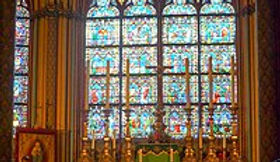Flying buttresses were used to alleviate the weight on the nave - which created a space between the nave and the support walls that could be filled with chapels.
Notre-Dame features 29 of these chapels - many dedicated to patrons of the cathedral and famous nobles.
They also provide insight into key French saints.
Saint Denis for example was the first bishop of Paris.
He is said to have been beheaded by the Romans on the hill of Montmartre, then picked up his head, continued to preach, and walked 10km before collapsing dead on the future location of the royal basilica of Saint-Denis.
He is now the patron-saint of Paris.
His chapel at Notre Dame also contains the tomb of the archbishop Affre - shot while trying to mediate with revolutionaries in 1848.
The Chapel of Saint George honors the patron saint of chivalry and, today, the patron saint of England.
The legend goes that he was a Greek officer in the 4th century who saved a village from a dragon and was beheaded for refusing to persecute Christians.
His chapel at Notre Dame also contains the tomb of archbishop Darboy - executed during the uprising of the Commune in 1871.
The chapel of Saint Guillaume can refer to either a 12th-century Italian noble who became a hermit, or a Scottish baker murdered by his adoptive son, who later became the patron-saint of adopted children!
The chapel also contains the tomb of Jean Jouvenel des Ursins, who rose from the son of a humble cloth merchant in the 14th-century to become the president of the Parliament of Paris.
It also contains the tomb of Henri d’Harcourt, Louis XIV's ambassador to Spain during the Spanish succession crisis.
Another significant artwork is the statue of Joan of Arc.
Born to a peasant family in the the 15th-century, during the Hundred Years War, she is renowned for helping French King Charles VII expel the English from France.
Captured by the Burgundians, she was handed her over to the English, convicted of heresy, and burnt at the stake.
20 years later, a retrial in Notre Dame Cathedral overturned her conviction - and this statue commemorates that moment.















.jpg)